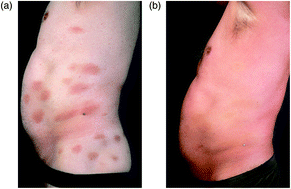当前位置:
X-MOL 学术
›
Photochem. Photobiol. Sci.
›
论文详情
Our official English website, www.x-mol.net, welcomes your feedback! (Note: you will need to create a separate account there.)
Phototherapy of cutaneous T-cell lymphomas
Photochemical & Photobiological Sciences ( IF 3.1 ) Pub Date : 2018-10-11 00:00:00 , DOI: 10.1039/c8pp00170g Franz Trautinger 1, 2, 3, 4, 5
Photochemical & Photobiological Sciences ( IF 3.1 ) Pub Date : 2018-10-11 00:00:00 , DOI: 10.1039/c8pp00170g Franz Trautinger 1, 2, 3, 4, 5
Affiliation

|
Cutaneous T-cell lymphomas (CTCL) are a heterogenous group of non-Hodgkin lymphomas arising in the skin. Mycosis fungoides (MF), the most common variant, is characterised by clonal proliferation of skin residing malignant T-cells. Initially appearing with erythematous patches and plaques it follows a chronic course with progression to cutaneous tumours and extracutaneous involvement in some patients. Phototherapy with ultraviolet A radiation combined with 8-methoxypsoralen (PUVA) and with narrow-band ultraviolet B radiation (NB-UVB) are among the first line options for the treatment of MF and can induce remission in most patients. Sézary syndrome (SS) is a rare and more aggressive CTCL variant with generalized skin involvement. Patients with SS and with erythroderma from MF can benefit from treatment with extracorporeal photochemotherapy (ECP) where peripheral blood is exposed to PUVA. Phototherapy can be safely combined with systemic agents, most notably interferon-alpha and retinoids. Another photoresponsive CTCL variant is lymphomatoid papulosis (LP), a CD30+ lymphoproliferative disease characterised by chronically recurring papules. The disease responds favourably to PUVA but low dose methotrexate might be preferred for long term disease control. Recently updated treatment guidelines have been published to provide evidence-based algorithms for the stage-oriented treatment of MF, SS and LP. Areas of uncertainty are treatment schedules that are currently not optimised for CTCL, the use of phototherapy for maintenance, and the value of ultraviolet A1 radiation, excimer lasers, and photodynamic therapy.
中文翻译:

皮肤T细胞淋巴瘤的光疗
皮肤T细胞淋巴瘤(CTCL)是皮肤中非霍奇金淋巴瘤的异质性组。蕈样真菌病(MF)是最常见的变体,其特征是皮肤上存在恶性T细胞的克隆增殖。最初出现红斑和斑块,随后出现慢性病程,进展为皮肤肿瘤,部分患者累及皮肤外。紫外线A辐射与8-甲氧基补骨脂素(PUVA)结合以及窄带紫外线B辐射(NB-UVB)的光疗是治疗MF的首选方法,在大多数患者中可以缓解。Sézary综合征(SS)是一种罕见且更具侵略性的CTCL变体,广泛累及皮肤。患有SS和MF的红皮病的患者可以受益于体外光化学疗法(ECP)的治疗,因为外周血暴露于PUVA。光疗可以与全身性药物安全地结合使用,最显着的是干扰素-α和类维生素A。另一个光反应性CTCL变体是淋巴瘤样丘疹(LP),一种CD30 +淋巴增生性疾病,其特征是慢性复发性丘疹。该疾病对PUVA的反应良好,但长期控制疾病可能首选低剂量甲氨蝶呤。最近发布了最新的治疗指南,旨在为MF,SS和LP的分阶段治疗提供循证算法。不确定性范围包括目前尚未针对CTCL优化的治疗方案,使用光疗进行维护以及紫外线A1辐射的价值,
更新日期:2018-10-11
中文翻译:

皮肤T细胞淋巴瘤的光疗
皮肤T细胞淋巴瘤(CTCL)是皮肤中非霍奇金淋巴瘤的异质性组。蕈样真菌病(MF)是最常见的变体,其特征是皮肤上存在恶性T细胞的克隆增殖。最初出现红斑和斑块,随后出现慢性病程,进展为皮肤肿瘤,部分患者累及皮肤外。紫外线A辐射与8-甲氧基补骨脂素(PUVA)结合以及窄带紫外线B辐射(NB-UVB)的光疗是治疗MF的首选方法,在大多数患者中可以缓解。Sézary综合征(SS)是一种罕见且更具侵略性的CTCL变体,广泛累及皮肤。患有SS和MF的红皮病的患者可以受益于体外光化学疗法(ECP)的治疗,因为外周血暴露于PUVA。光疗可以与全身性药物安全地结合使用,最显着的是干扰素-α和类维生素A。另一个光反应性CTCL变体是淋巴瘤样丘疹(LP),一种CD30 +淋巴增生性疾病,其特征是慢性复发性丘疹。该疾病对PUVA的反应良好,但长期控制疾病可能首选低剂量甲氨蝶呤。最近发布了最新的治疗指南,旨在为MF,SS和LP的分阶段治疗提供循证算法。不确定性范围包括目前尚未针对CTCL优化的治疗方案,使用光疗进行维护以及紫外线A1辐射的价值,



























 京公网安备 11010802027423号
京公网安备 11010802027423号